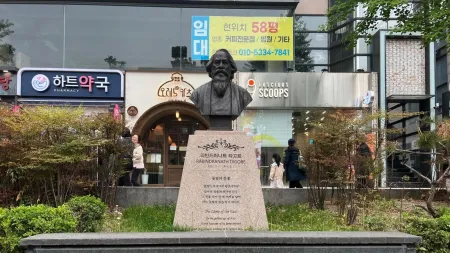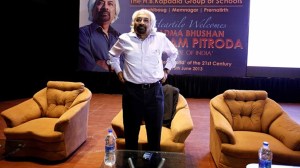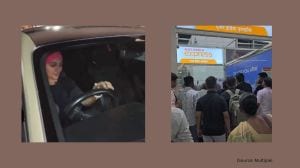- India
- International
Jews and Brahmins — West would like you to see them as oppressors alone. They are victims
The Brahmin of the ‘progressive’ imagination is little different from the ‘Jew’ of the Nazi imagination in art and popular culture. And both have a long, painful past in the history of Islamic and Christian imperialism around the world
 California Governor Gavin Newsom recently vetoed the controversial caste bill. (Photo: AP)
California Governor Gavin Newsom recently vetoed the controversial caste bill. (Photo: AP) California Governor Gavin Newsom has vetoed Senate Bill 403 (SB403), the controversial caste bill introduced by Democratic Afghan-American State Senator Aisha Wahab (who now faces a recall campaign by some of her own constituents).
Coming as this did, in the wake of the horrifying attacks on Israel by Hamas, and the heartless blame-the-victim response to the same by some South Asian activists in American universities like Harvard, it is worth understanding the bigger picture on how current discourses about racism, Zionism, and Hindutva have informed (or misinformed) the anti-caste project.
As Prakash Shah notes in his important study, Against Caste in British Law, the 2001 World Conference Against Racism, Racial Discrimination, Xenophobia and Related Intolerance was a key moment in the internationalisation of caste as a global problem similar to race. India and Israel were both said to be guilty of apartheid due to “the caste system” and “Zionism” respectively.
The NDA government at the time pushed back against such a characterisation, declaring caste concerns an internal matter. But since that time, as Shah noted, the Indian diaspora and particularly Hindus among them, have been the subject of anti-caste laws or demands for such laws in multiple locations, including the UK, Mauritius, and now, the US.
The Cisco case
In the US, much of the case for anti-caste laws was made on the basis of a survey by an organisation called Equality Labs and a highly publicised case of alleged caste discrimination by two south Indian-origin Brahmin managers at Cisco.

The defendants, Sundar Iyer and Ramana Kompella, were named and shamed for years by the media, activists and academics as the investigation proceeded. At an anti-Hindutva conference held on the anniversary of the 9/11 attacks in 2021, they were called “corporate malignant Brahmins.”
When Cisco failed to find proof of caste discrimination, a controversial California government bureau continued the investigation. Finally, in 2023, the case against Iyer and Kompella was dismissed, while the state Civil Rights Department case continues against Cisco.
Iyer has since then disclosed some key facts. The complainant, “John Doe,” said he was not chosen for a position because he was a Dalit but the person selected instead also happened to be Dalit. Iyer says Mr Doe had actually not even applied for the position he claimed he was denied due to caste. The whole trial, by the media and by state authorities seems to have been a fact-free witch-hunt (the website castegate.org has documented some of the facts).
California caste law polarises
Facts aside, the whole “caste in the diaspora” movement has been punctuated all along by differences in class, caste, generational location, and social and educational capital. In numerous public hearings these past few years, a pattern has played out.
The strongest support for SB403 seems to have come from young second-generation Indian-Americans professing Brahmin or upper-caste privilege and claiming caste laws are needed because their parents were casteist.
The strongest opponents of SB403 have been mainly first-generation immigrants, such as the late Dalit-Bahujan Hindu community leader Milind Makwana.
It is not surprising that there has been deep polarisation in the community around this issue, with the two sides accusing each other of Hindutva or Hinduphobia. But the real issue is less about Left versus Right, but about Truth (or at least debate) versus Propaganda (and censorship).
It is on this point that the role of the media and academia is relevant. Both institutions, normally entrusted by citizens in a democracy with the duty of truth-keeping through debate, have failed.
In a recent “X” space discussion on the veto, many opponents of the bill complained that most media outlets in the US denied them a voice. There were reportedly 53,000 mentions of caste in the media in the past two years, but little diversity of opinion was permitted.
Even the way that most news outlets framed the veto is instructive. The San Francisco Chronicle’s headline called the veto a “surprise … blow to caste-based civil rights movement” while Reuters editorialised that the veto “sets back North American fight against caste discrimination.” Such language tacitly endorses the claims of the pro-bill lobby while silencing the concerns of the opponent. This could have been easily avoided with terms like “disputed,” or by quoting the Governor’s own rationale for rejection — the bill was redundant because caste discrimination is already banned by current laws.
Dishonesties of civil rights movement
That this supposed civil rights movement was marked by repeated dishonesties and hateful sloganeering of the sort that characterise a powerful influence campaign rather than a cry of the oppressed, is evident.
Academia, and media, have become oppression-certificate-mills, rather than nurturing environments for the pursuit of both truth and justice.
And this pursuit is going to require some honest reappraisal of the way in which anti-Semitism and Hinduphobia have been normalised under the guise of anti-Zionist and anti-Hindutva or anti-caste movements in recent times.
This investigation is needed not because of some Israeli-India Islamophobia conspiracy as critics fear but because it is a fact that the discourse on caste, Brahmins, and Hindus has been fed since colonial times by anti-Semitic and anti-heathen hatred.
The Brahmin, and often even “the Hindu,” of the “progressive” imagination is little different from the “Jew” of the Nazi imagination in art and popular culture. And both have a long, painful past in the history of Islamic and Christian imperialism around the world.
It is incredible to witness how much an influence campaign can change victims into seeming like oppressors. The 2001 UN World Conference against Racism, which began decades earlier with concerns about the dehumanisation of Jews leading to the Holocaust, has now left us with a new class of differently dehumanised transnational elites determined to cast Hindus and Jews as permanent oppressors and their elimination as the only way to end racism.
What truly needs a veto is not just a bill, but the lies that lead to genocides as a whole.
The writer is Professor of Media Studies, University of San Francisco
EXPRESS OPINION
More Explained
May 08: Latest News
- 01
- 02
- 03
- 04
- 05












































